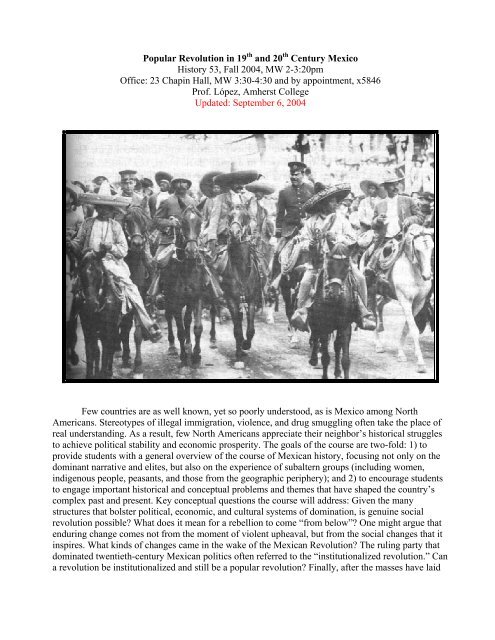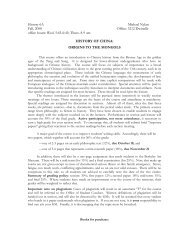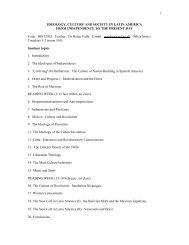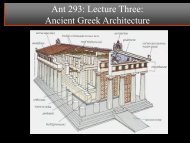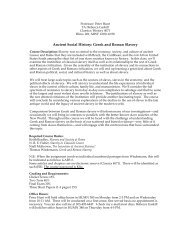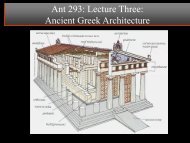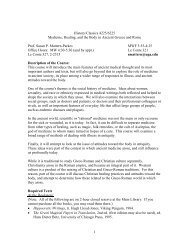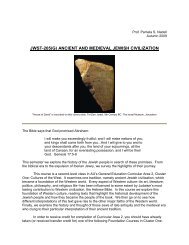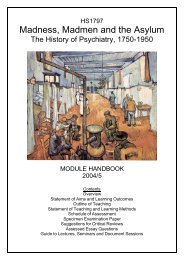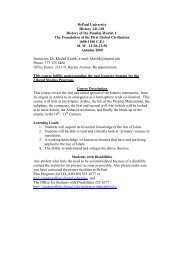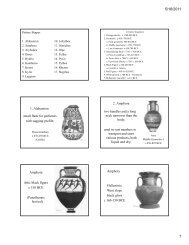Popular Revolution in 19th and 20th Century Mexico History 53, Fall ...
Popular Revolution in 19th and 20th Century Mexico History 53, Fall ...
Popular Revolution in 19th and 20th Century Mexico History 53, Fall ...
- No tags were found...
Create successful ePaper yourself
Turn your PDF publications into a flip-book with our unique Google optimized e-Paper software.
López, <strong>Mexico</strong>, p6population, <strong>in</strong>clud<strong>in</strong>g women, peasants, <strong>in</strong>digenous peoples, hacendados, <strong>and</strong> the new bourgeoisie.We will also try to underst<strong>and</strong> the po<strong>in</strong>ts of cohesion <strong>and</strong> stress with<strong>in</strong> Porfirian society.Monday, September 20: The Porfirian Political System• (book) MSD, 413-459.• (book) Alan Knight, “Porfirian <strong>Mexico</strong>: People, Places, the Regime,” The Mexican<strong>Revolution</strong>: Volume 1, Porfirian, Liberals <strong>and</strong> Peasants (L<strong>in</strong>coln, Nebraska: University ofNebraska, 1986), 1-36.• (book) <strong>Mexico</strong> Reader, 273-284.• Discussion leaders(s): _____________________________Wednesday, September 22: Cities <strong>in</strong> the Porfirian Imag<strong>in</strong>ation• (coursepack) Allen Wells <strong>and</strong> Gilbert Joseph, “Moderniz<strong>in</strong>g Visions, Chilango Bluepr<strong>in</strong>ts,<strong>and</strong> Prov<strong>in</strong>cial Grow<strong>in</strong>g Pa<strong>in</strong>s: Merida at the Turn of the <strong>Century</strong>,” Mexican Studies/EstudiosMexicanos 8(2)(Summer 1992): 167-215.• (coursepack) Mauricio Tenorio Trillo, “1910 <strong>Mexico</strong> City: Space <strong>and</strong> Nation <strong>in</strong> the City ofthe Centenario,” Journal of Lat<strong>in</strong> American Studies 28(1)(February 1996): 75-104.• (coursepack) Luis González y González, San José de Gracia: Mexican, translated by JohnUpton (UT Aust<strong>in</strong>, 1974 [orig<strong>in</strong>ally published <strong>in</strong> Spanish 1972]) 78-112.• Discussion leaders(s): _____________________________Monday, September 27: Porfirian Centralization <strong>and</strong> ModernizationMAP QUIZ TODAY!• (coursepack) Juan Mora-Torres, The Mak<strong>in</strong>g of the Mexican Border: The State, Capitalism,<strong>and</strong> Society <strong>in</strong> Nuevo León, 1848-1910 (Aust<strong>in</strong>: University of Texas Press, 2001), 52-125• Discussion leaders(s): _____________________________Part 4: The <strong>Revolution</strong>Though we normally speak of the Mexican <strong>Revolution</strong>, <strong>in</strong> actuality, it was not one, butmultiple revolutions. Opposition to the Díaz regime came from peasant villages, social b<strong>and</strong>its, localwarlords, old-style Liberal political reformers, the new bourgeoisie, <strong>and</strong> anti-capitalist radicals.Though these groups <strong>in</strong>itially united around the figure of Francisco Madero <strong>and</strong> h<strong>and</strong>ily overthrewthe Díaz regime, their alliance quickly broke down, the Mexican government virtually dissolved, <strong>and</strong>the Mexican masses entered a chaotic period of fight<strong>in</strong>g known as “La bola [the Great Tumult].” Wewill try to make sense of this seem<strong>in</strong>gly chaotic situation by trac<strong>in</strong>g the evolution <strong>and</strong> transformationof the struggle <strong>and</strong> the participants dur<strong>in</strong>g the ten-year <strong>Revolution</strong>. We will also try to discern thenature of this <strong>Revolution</strong>.Wednesday, September 29: The New Opposition• (book) MSD, 463-478• (book) Knight, The Mexican <strong>Revolution</strong> 37-77• (book) <strong>Mexico</strong> Reader, 285-291• 20 m<strong>in</strong>ute presentation by Michael Kasper• Discussion leaders(s): _____________________________
López, <strong>Mexico</strong>, p7Monday, October 4: The <strong>Popular</strong> Roots of Rebellion• (book) Knight, Mexican <strong>Revolution</strong>, 78-170• Discussion leaders(s): _____________________________DUE TUESDAY, OCTOBER 5, NOON: H<strong>and</strong> <strong>in</strong> a short description (70 to 100 words) of yourterm paper topic <strong>and</strong> what issue they will explore with<strong>in</strong> that topic. Also turn <strong>in</strong> a list of potentialworks you will <strong>in</strong>corporate <strong>in</strong>to your f<strong>in</strong>al paper. List 2 books, 3 essays from compilations, <strong>and</strong> 5articles from peer reviewed journals.Screen<strong>in</strong>g: Elia Kazan’s, ¡Viva Zapata! starr<strong>in</strong>g Marlon Br<strong>and</strong>oTuesday, October 5, 4 & 7:30pmWednesday, October 6: The <strong>Revolution</strong>, Part I• (book) MSD, 478-520• (book) <strong>Mexico</strong> Reader, 339-62• (Film, to be viewed <strong>in</strong> advance) Elia Kazan’s, ¡Viva Zapata! starr<strong>in</strong>g Marlon Br<strong>and</strong>oScreen<strong>in</strong>g: Old Gr<strong>in</strong>goThursday, October 7, 4 & 7:30pmMONDAY, OCTOBER 11: FALL BREAKWednesday, October 13: No class meet<strong>in</strong>gDUE TODAY BY 4PM: Turn <strong>in</strong> a typed <strong>and</strong> formatted 1 page description of topic, <strong>and</strong> anexplanation of the major issues <strong>and</strong> how they have been addressed <strong>in</strong> the literature. Also h<strong>and</strong> <strong>in</strong>analytical annotations of 1 book, 1 essay from a compilation, <strong>and</strong> 3 scholarly peer-reviewed journalarticles.Monday, October 18: The <strong>Revolution</strong>, Part II• (book) MSD, 320-342.• (book) <strong>Mexico</strong> Reader, 364-74; 398-402.• (coursepack) Nellie Campobello, Cartucho/ My Mother’s H<strong>and</strong>s, translated by Doris Meyer(UT Aust<strong>in</strong> 1988 [Spanish orig<strong>in</strong>al, 1938]), 5-34.• (Film, to be viewed <strong>in</strong> advance) The Old Gr<strong>in</strong>goWednesday, October 20: Interpret<strong>in</strong>g the <strong>Revolution</strong>: From Romanticism, to Revisionism, toPostrevisionism• (coursepack) Gilbert Joseph & Daniel Nugent, eds., Everyday Forms of State Formation:<strong>Revolution</strong> <strong>and</strong> the Negotiation of Rule <strong>in</strong> Modern <strong>Mexico</strong> (Durham, NC: Duke UP, 1994), 3-66.• (book) <strong>Mexico</strong> Reader, 375-397.• Discussion leaders(s): _____________________________Part 5: Build<strong>in</strong>g the <strong>Revolution</strong>ary State <strong>and</strong> Forg<strong>in</strong>g the Mexican NationThe <strong>Revolution</strong> tore <strong>Mexico</strong> apart. The state dissolved as authority fell <strong>in</strong>to the h<strong>and</strong>s ofregional strongmen, or caudillos. The economy was <strong>in</strong> shambles. In a decade of warfare <strong>Mexico</strong> lost10% of its population. The press<strong>in</strong>g task of the postrevolutionary government led by the triumphantNorthern General Álvaro Obregón was to rebuild state <strong>and</strong> society <strong>and</strong> to reestablish <strong>and</strong> legitimate
López, <strong>Mexico</strong>, p8the authority of the Obregonista government as heir to the <strong>Revolution</strong>. Many <strong>in</strong>tellectuals <strong>and</strong>political leaders saw this as an opportunity not only to rebuild society, but to build a better morecohesive nation. We will cover some of the major figures <strong>and</strong> their views on what was to be done.We pay particular attention to the effort to create a modern, <strong>in</strong>tegrated, <strong>and</strong> sovereign Mexicannation, <strong>and</strong> the emerg<strong>in</strong>g ideas about how to deal with the “agrarian problem” <strong>and</strong> the “Indianproblem.” We will also cover the efforts by <strong>in</strong>tellectuals, artists, popular groups, <strong>and</strong> political leaderto f<strong>in</strong>d mean<strong>in</strong>g <strong>in</strong> the upheaval they had just been through.Monday, October 25: Giv<strong>in</strong>g the <strong>Revolution</strong> a M<strong>and</strong>ate• (book) MSD, 547-559• (coursepack) Moisés Sáenz, “<strong>Mexico</strong>: An Appraisal <strong>and</strong> a Forecast,” pamphlet.• (coursepack) Survey Graphic 5(2)(1924): Frank Tannenbaum, “<strong>Mexico</strong>—A Promise” (129-132); Felipe Carrillo, “The New Yucatán” (138-142); Manuel Gamio, “The New Conquest”(143-146, 192-194); Pedro Henríquez Ureña, “The <strong>Revolution</strong> <strong>in</strong> Intellectual Life”• Discussion leaders(s): _____________________________Screen<strong>in</strong>g: FridaMonday, October 25, 4 & 7:30pmWednesday, October 27: Forg<strong>in</strong>g the Nation <strong>and</strong> Construct<strong>in</strong>g lo mexicanoMEET IN MEAD ART MUSEUM• (book) MSD, 560-572.• (coursepack) Helen Delpar, “Mexican Culture,” Oxford <strong>History</strong> of <strong>Mexico</strong> (New York:University of Oxford Press, c2000), 543-572.• (coursepack) Karen Cordero Reiman, “Construct<strong>in</strong>g a Modern Mexican Art, 1910-1940,”from South of the Border, edited by James Oles (Wash<strong>in</strong>gton: Smithsonian, 1993), 10-47.• (film, to be viewed <strong>in</strong> advance) Frida• Discussion will be supplemented by video, music, <strong>and</strong> art slides.• Discussion leaders(s): _____________________________DUE: OCTOBER 29, 4PM: Turn <strong>in</strong> your research paper, 2700-3300 words plus footnotes, 12 po<strong>in</strong>tTimes font, name <strong>and</strong> page number on every sheet, stapled.Monday, November 1: Counter-<strong>Revolution</strong>• (coursepack) Thomas Benjam<strong>in</strong>, “Rebuild<strong>in</strong>g the Nation,” Oxford <strong>History</strong> of <strong>Mexico</strong>.• (coursepack) Jenny Purnell, <strong>Popular</strong> Movements <strong>and</strong> State Formation <strong>in</strong> <strong>Revolution</strong>ary<strong>Mexico</strong>: Agraristas <strong>and</strong> Cristeros <strong>in</strong> Michoacán (Durham: Duke UP, 1999). 1-23.• (book) <strong>Mexico</strong> reader, 421-425; 439-44.• Discussion leaders(s): _____________________________
López, <strong>Mexico</strong>, p9Wednesday, November 3: Cardenismo• (book) MSD, 574-586.• (coursepack) Alan Knight, “The Rise <strong>and</strong> <strong>Fall</strong> of Cardenismo,” from <strong>Mexico</strong> S<strong>in</strong>ceIndependence, ed. by Leslie Bethell (New York: Cambridge UP, 1991), 241-320.• (book) <strong>Mexico</strong> Reader, 4<strong>53</strong>-455.• Discussion leaders(s): _____________________________DUE FRIDAY, NOVEMBER 5, 4PM: H<strong>and</strong> <strong>in</strong> a short description (70 to 100 words) of your termpaper topic <strong>and</strong> what issue they will explore with<strong>in</strong> that topic. Also turn <strong>in</strong> a list of potential worksyou will <strong>in</strong>corporate <strong>in</strong>to your f<strong>in</strong>al paper. List 2 books, 3 essays from compilations, <strong>and</strong> 5 articlesfrom peer reviewed journals.Monday, November 8: Myth, Memory, <strong>and</strong> <strong>Revolution</strong>, Part I• (book) MSD, 586-600.• (coursepack) Mary Kay Vaughan, Cultural Politics <strong>in</strong> <strong>Revolution</strong> (Tucson, AZ: University ofArizona Press, 1997), 3-46.• Discussion leaders(s): _____________________________Wednesday, November 10: Myth, Memory, <strong>and</strong> <strong>Revolution</strong>, Part II• (coursepack) Thomas Benjam<strong>in</strong>, La Revolución: <strong>Mexico</strong>’s Great <strong>Revolution</strong> as Memory,Myth <strong>and</strong> <strong>History</strong> (Aust<strong>in</strong>: University of Texas Press, 2000), 93-151 & 157-165.• (coursepack) Jan Rus, “The Comunidad Revolucionaria Institucional: The Subversion ofNative Government <strong>in</strong> Highl<strong>and</strong> Chiapas, 1936-1968,” Everyday Forms of State Formation,265-300.• Discussion leaders(s): _____________________________Part 6: “Politics of the Poster”After the 1930s, <strong>Mexico</strong> entered a period of massive urban growth <strong>and</strong> <strong>in</strong>dustrialization, <strong>and</strong> the stateCardenas had created now ab<strong>and</strong>oned the social idealism of Cardenismo. Under one-party rule,Mexican politics became corrupt <strong>and</strong> devoid of any ideology. The ideals of the revolution seemed torecede <strong>in</strong>to the past, while the PRI adopted the term “Institutionalized <strong>Revolution</strong>” to describe itscorporate politics. By the end of the 1960s, a new generation of citizens <strong>and</strong> <strong>in</strong>tellectuals expressedtheir disillusionment with PRI mach<strong>in</strong>e politics <strong>and</strong> the “ideology of the poster.” Protest culm<strong>in</strong>ated<strong>in</strong> 1968 with a massive student movement, upon which the government unleashed the army, creat<strong>in</strong>ga civil crisis that Mexicans cont<strong>in</strong>ue to wrestle with today. With this violent repression, thegovernment seemed to lose most of its already threatened credibility. But it had succeeded <strong>in</strong>dispers<strong>in</strong>g opposition, which was reduced to isolated guerrilla movements <strong>in</strong> southern <strong>Mexico</strong>, <strong>and</strong> tothe compla<strong>in</strong>ts of disheartened <strong>in</strong>tellectuals <strong>and</strong> academics bent on expos<strong>in</strong>g the lies that legitimatedthe regime. The PRI not only survived this crisis, it grew stronger. Dur<strong>in</strong>g the 1970s, the PRI shoredup its peasant base through a new wave of nationalism <strong>and</strong> l<strong>and</strong> redistribution. <strong>Mexico</strong> entered its“economic miracle” f<strong>in</strong>anced through an oil boom, but corruption <strong>and</strong> theft of treasury fundsexp<strong>and</strong>ed, <strong>and</strong> the PRI cont<strong>in</strong>ued to dom<strong>in</strong>ate national politics by any means necessary. How did thePRI pull it off? And at what cost?
López, <strong>Mexico</strong>, p10Monday, November 15: Build<strong>in</strong>g a New <strong>Mexico</strong> <strong>in</strong> the Post WWII Era• (book) MSD, 603-635.• (coursepack) Enrique Krauze, <strong>Mexico</strong>: Biography of Power, trans. Hank Heifetz (New York:HarperColl<strong>in</strong>es, 1997), 526-600.• Discussion leaders(s): _____________________________• DUE TODAY IN CLASS: Turn <strong>in</strong> a typed <strong>and</strong> formatted 1 page description of topic, <strong>and</strong> anexplanation of the major issues <strong>and</strong> how they have been addressed <strong>in</strong> the literature. Also h<strong>and</strong><strong>in</strong> analytical annotations of 1 book, 1 essay from a compilation, <strong>and</strong> 3 scholarly peer-reviewedjournal articles.Screen<strong>in</strong>g: <strong>Mexico</strong>, the Frozen <strong>Revolution</strong> (1972, directed by Raymundo Gleyzer)Monday, November 15, 4 & 7:30pmMonday, November 22 –Wednesday, November 24: Thanksgiv<strong>in</strong>g RecessMonday, November 29: Idealism <strong>and</strong> the Unmask<strong>in</strong>g of Authoritarianism• (book) Elena Poniatowska, Massacre <strong>in</strong> <strong>Mexico</strong>, translated by Helen Lane (Columbia:University of Missouri Press, 1991 [1975]), vii-xvii; 325-333; 174-198; 3-10; 17-22; 47-58; 62; 70-72; 74-75; 81; 92-93; 105-111; 118-119; 134-137; 146-151; 199-229; 238-240;262-263; 268-272; 311-321.• (Film, to be viewed <strong>in</strong> advance) <strong>Mexico</strong>, the Frozen <strong>Revolution</strong> (1972, dir. RaymundoGleyzer)Part 7: 1970s to TodayBetween 1990 <strong>and</strong> the present, <strong>Mexico</strong> has seen dramatic change. Though pundits had long hailed thecollapse of the one-party system, no one thought it would ever really happen. In 1988, the oppositionparty PRD won the presidential elections, only to see their triumph stolen out from under them. ThePRI under the leadership of president Sal<strong>in</strong>as de Gortari undid much of the l<strong>and</strong> reform born of the<strong>Revolution</strong>, negotiated passage of the North American Free Trade Agreement, <strong>and</strong> oversaw aremarkable rate of macroeconomic growth. But the outbreak of the Zapatista rebellion (named afterits 1910 forebear) rem<strong>in</strong>ded the world about the persistence of <strong>in</strong>equality <strong>in</strong> <strong>Mexico</strong> <strong>and</strong> the fate ofthose left beh<strong>in</strong>d. At the end of his term, Sal<strong>in</strong>as fled <strong>in</strong>to exile <strong>in</strong> Irel<strong>and</strong> amid the revelation ofunheard of levels of graft <strong>and</strong> government mismanagement. For the first time, residents of <strong>Mexico</strong>City were allowed to elect their own mayor, <strong>and</strong> the post went to the Left of Center opposition partythe PRD. Students at the National University went on strike <strong>in</strong> opposition to neo-Liberal reforms ofeducation <strong>and</strong> the economy, <strong>and</strong>, at the height of the protest there was widespread fear that the PRIwould orchestrate a repeat of 1968. In 2000, the impossible became a reality. The PRI lost thepresidency, <strong>and</strong>, after a 70 year political monopoly over the Executive, conceded the office to theConservative PAN c<strong>and</strong>idate, Vicente Fox. President Fox (ex CEO of Coca-Cola <strong>Mexico</strong>) hasgrappled with the grow<strong>in</strong>g <strong>in</strong>fluence of transnational Mexicans resid<strong>in</strong>g <strong>in</strong> the United States, theopen<strong>in</strong>g of <strong>in</strong>vestigations <strong>in</strong>to human rights abuses under the PRI, the reactions of the PRI, thecont<strong>in</strong>uation of the Zapatista rebellion <strong>in</strong> Chiapas <strong>and</strong> rebellions <strong>in</strong> Guerrero, <strong>and</strong> grow<strong>in</strong>g cleavagesover the issues of free trade <strong>and</strong> migration. We will consider these developments <strong>in</strong> an effort tounderst<strong>and</strong> the fate of the popular <strong>Revolution</strong>, <strong>and</strong> to grapple with the questions of whether the<strong>Revolution</strong> made a difference <strong>in</strong> the long term.
López, <strong>Mexico</strong>, p11Wednesday, December 1: Challenges of the 1970s through the 1990s• (book) MSD, 637-75.• (coursepack) Wayne Cornelius, Mexican Politics <strong>in</strong> Transition: The Breakdown of a One-Party-Dom<strong>in</strong>ant Regime (San Diego: UC Press, 1996), 25-49.• (book) <strong>Mexico</strong> Reader, 579-597 & <strong>53</strong>6-544.• Discussion leaders(s): _____________________________Monday, December 6: Mak<strong>in</strong>g Sense of <strong>Mexico</strong>’s Exceptionalism <strong>and</strong> Stability• (coursepack) Alan Knight, “The Peculiarities of Mexican <strong>History</strong>: <strong>Mexico</strong> Compared to Lat<strong>in</strong>America, 1821-1992,” Journal of Lat<strong>in</strong> American Studies, vol. 24 (qu<strong>in</strong>centarysupplement)(1992): 99-144.• Discussion leaders(s): _____________________________Screen<strong>in</strong>g, watch one of the follow<strong>in</strong>g two films: Zapatistas (<strong>in</strong> Spanish) or A Place Called Chiapas(<strong>in</strong> English). A Place Called Chiapas will be screened on Monday, December 6, 4 & 7:30pm.Zapatistas is available on reserve for you to watch <strong>in</strong>dividually or <strong>in</strong> groups.Wednesday, December 8: Movements <strong>in</strong> the 1990s• (coursepack) John Holloway <strong>and</strong> Eloína Peláez, “Re<strong>in</strong>vent<strong>in</strong>g <strong>Revolution</strong>,” Zapatista!:Re<strong>in</strong>vent<strong>in</strong>g <strong>Revolution</strong> <strong>in</strong> <strong>Mexico</strong> (Sterl<strong>in</strong>g, VA: Pluto Press, 1998), 1-18.• (coursepack) Documents <strong>in</strong> John Womack, Jr. (editor), Rebellion <strong>in</strong> Chiapas (New York: NewPress, 1999), 245-295.• (book) <strong>Mexico</strong> Reader, 670-683.• (Film, view before class) If you underst<strong>and</strong> Spanish, watch Zapatistas, by La Jornada (<strong>in</strong> itsentirety). If you do not underst<strong>and</strong> Spanish, watch A Place Called Chiapas.Discussion leaders(s): _____________________________Monday, December 13: In search of the <strong>Revolution</strong>• (book) MSD, 675-697.• (book) Carlos Fuentes, The Crystal Frontier (New York: Harcourt Brace, 1997) (realistfiction), 3-144• (coursepack) Celia W. Dugger, “Report F<strong>in</strong>ds Few Benefits for <strong>Mexico</strong> <strong>in</strong> NAFTA,” NewYork Times, 19 November 2003.o Recommended: (download from Blackboard site) John Audley, DemetriosPapademetriou, S<strong>and</strong>ra Polaski, Scott Vaughan, NAFTA's Promise <strong>and</strong> Reality:Lessons from <strong>Mexico</strong> for the Hemishphere (Carnegie Endowment Report, Nov. 2004).• Discussion leaders(s): _____________________________Screen<strong>in</strong>g: Amorres Perros, directed by IñarrituMonday, December 13, 4 & 7:30pmWednesday, December 15: Is the <strong>Revolution</strong> Dead?• (book) Carlos Fuentes, The Crystal Frontier (New York: Harcourt Brace, 1997) (realistfiction), 145-266.• (book) <strong>Mexico</strong> Reader, 598-618 & 750-755.• (Film, view before class) Amorres Perros, directed by Iñarritu• In class view images from Ricas y Famosas, <strong>and</strong> other art exhibitionsDiscussion leaders(s): _____________________________
López, <strong>Mexico</strong>, p12DUE: DECEMBER 21, 4PM: Turn <strong>in</strong> your research papers, 2700-3300 words plus footnotes, 12po<strong>in</strong>t Times font, name <strong>and</strong> page number on every sheet, stapled.Places to know for map quiz:Districts <strong>and</strong> States: Cities: Geographic features:The extent of <strong>Mexico</strong> <strong>in</strong> 1824Modern boundaries of:México DFChihuahuaYucatán (the state)OaxacaChiapasMichoacánGuerreroJaliscoGuanajuatoZacatecasNayaritCoahuilaMorelos<strong>Mexico</strong> CityGuadalajaraMéridaVeracruzOaxaca CityPuebla de los AngelesGuanajuatoTijuanaCiudad JuárezChihuahuaMonterreyAcapulcoZacatecasNogalesSan Luis PotosíYucatán pen<strong>in</strong>sulaBaja CaliforniaSierra Madre OrientalSierra Madre OccidentalIsthus of TehuantepecBajíoRío BravoLa Laguna (<strong>in</strong> Coahuila)Chihuahua DesertRío Lerma


